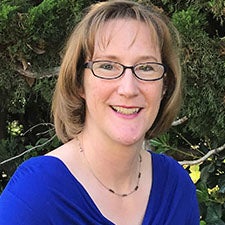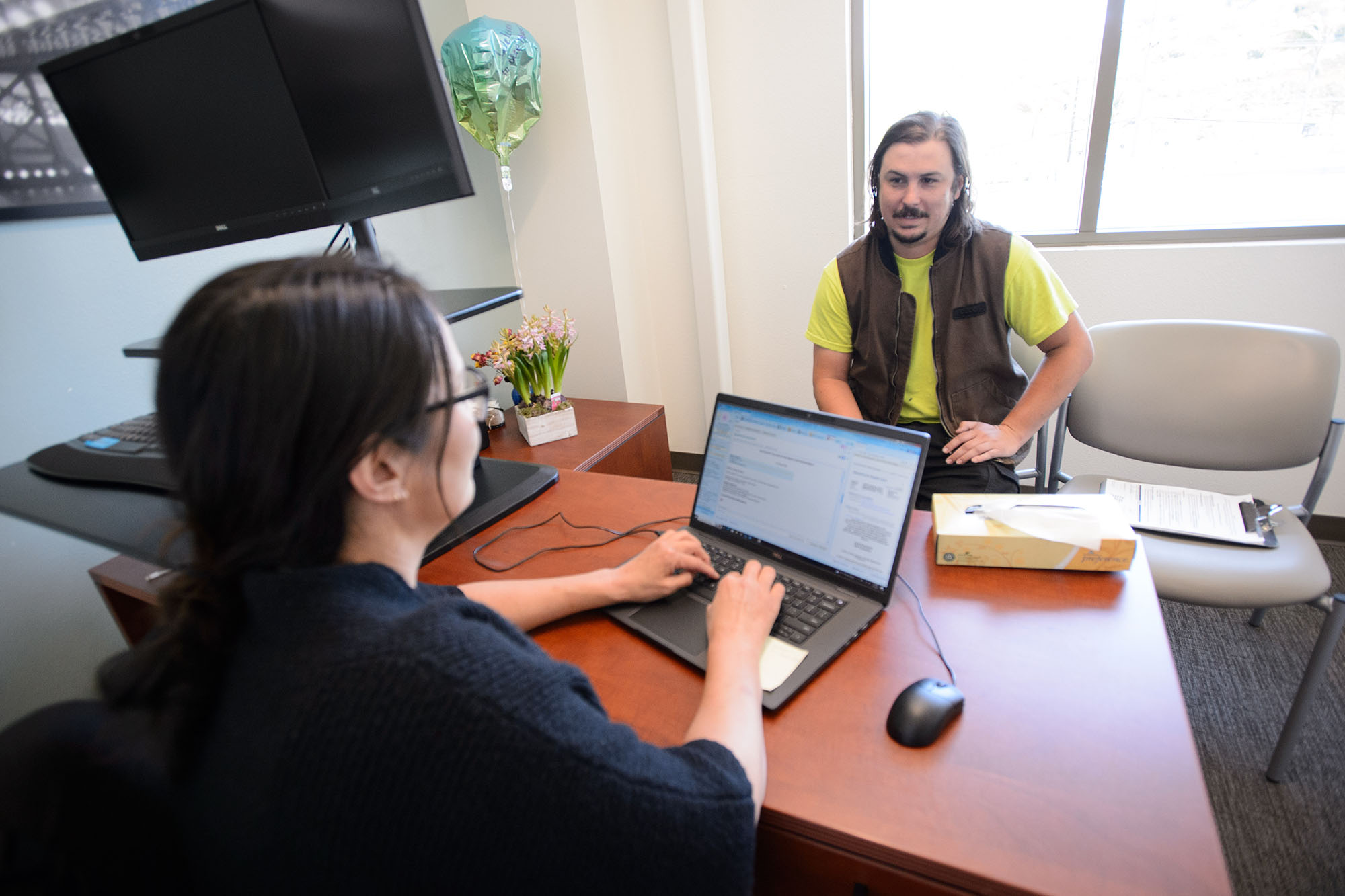
When Christy Richards learned she needed to complete a home health aide training course to work as a caregiver, she worried that her career aspirations would be blocked by her learning disability. The 48-year-old mother of two in Quincy, Massachusetts, had been a hairdresser for 25 years until hand pain from carpal tunnel syndrome and arthritis forced her to explore other job opportunities.
She joined a home health company and was surprised that the training was accessible on her mobile device and included videos demonstrating how to feed, bathe, and transfer clients with dementia, Parkinson’s disease, and other conditions. “I was expecting to get a thick packet with dense text and questions to answer,” said Richards, who has dyslexia. “The online training was a better way for me to learn, and I could go at my own pace.”
Richards is among nearly 500,000 caregivers nationwide who have been trained through the CareAcademy online platform to work with the country’s rapidly growing aging population since the company was started in 2016. The company’s founder and CEO, Helen Adeosun, recognized that there is high demand for caregivers — a classification that includes personal care aides, home health aides, and certified nurse assistants — yet this workforce lacked adequate training and pay from the health care system.
Adeosun’s perspective on caregivers, also known as direct care workers, was informed by personal experience. She worked as a caregiver herself and watched her parents regain credentials to work in home health after emigrating to the US from Nigeria, where they were direct care workers. “This process takes a tremendous amount of time, money, and effort when you’re trying to work and support your family,” she said. “If we have such a shortage of health care workers in this country, I didn’t understand why we made it so hard to attract people to the profession.”
Difficult Working Conditions
In California, demand for caregivers has been surging as the population ages. The number of direct care workers increased 242% from 2009 to 2019, according to a 2021 report from PHI — a national nonprofit group that focuses on all aspects of eldercare and disability services. This kind of work is known as direct care, and it is the single largest occupational category in California, the world’s fourth largest economy. This sector is expected to add 200,000 jobs from 2018 to 2028 as the number of Californians age 60 or older will reach 10.8 million by 2030. That is almost double what the size of that age group was a dozen years ago. Despite the critical need for caregivers, direct care jobs in the state are characterized by low compensation, insufficient training, and limited career paths, according to the report.
In California, the median hourly wage for direct care workers is $13.18. More than 80% of this workforce is female, 77% people of color, and 48% immigrants. “Many caregivers are doing hard work for little pay, and they are not getting the support they need,” said Melissa Buckley, director of the California Health Care Foundation’s Innovation Fund. “They may be caring for their own families and have multiple jobs, and it is often difficult to get to in-person training.” In 2022, the Innovation Fund invested in CareAcademy, which aligns with goals in the state’s Master Plan for Aging to address inequities in the direct care workforce and create one million high-quality caregiving jobs by 2031. One of the plan’s strategies is to expand online training platforms that equip caregivers with tools to succeed in their roles and provide quality care.
Education Is Power
Adeosun’s desire to leverage education for economic opportunity in underserved populations intensified after college when she joined Teach for America and worked as a ninth-grade teacher in Atlanta. She was bothered by the lack of attention paid to career pathways outside the traditional university track.
While Adeosun was pursuing her master’s degree in education at Harvard, she began developing an idea for a company that would address two significant problems simultaneously. “I wanted to make it easier for caregivers to get certified and onboard while also helping to meet the demands of an aging population that needed quality care,” she said.
After graduating, she began building a virtual training product for caregivers and a core team of executives for a start-up called CareAcademy. Her first clients were in California, where the state had enacted the Home Care Services Consumer Protection Act in 2016. As a result, home care organizations were required to institute training programs for home care aides.
CareAcademy offers more than 500 online learning resources with classes available in multiple languages. In addition, CareAcademy’s home health aide training curriculum combines 16 hours of in-person instruction with 59 hours of online classes. Caregivers can also earn certifications in safety and fall prevention, COVID-19 care, and several other areas.
In California, In-Home Supportive Services (a program administered by the state’s Department of Social Services and Department of Health Care Services) uses CareAcademy, as do 90 private home care organizations operating in in San Joaquin, Contra Costa, and San Diego Counties. CareAcademy also works with Cedars-Sinai in Southern California to provide training videos for 50 promotores — community health workers focused on serving the Latino/x population — who staff a community-based oncology program.
“Before the Protection Act was passed in 2016, many caregivers were performing tasks beyond their skillset and working in unsafe conditions,” said Natalie Fritz, regional caregiver support team manager for TheKey, a home caregiving agency that employs caregivers in the United States and Canada. “CareAcademy’s courses teach caregivers how to develop skills to protect themselves on the job.”
Fritz remembers one caregiver who was struggling with a client suffering from dementia and experiencing sundowning — agitation and confusion that begins or worsens as daylight fades. The client started pacing and became aggressive during the evenings. The caregiver’s manager assigned the caregiver to take a CareAcademy class that focused on clients with dementia, in addition to TheKey’s Enhanced Dementia training. “She learned techniques like showing the client the time on the clock and the darkness outside let him know it was time for bed,” Fritz said.
CareAcademy also allows caregivers to electronically track the training they have completed to position themselves for raises and other job opportunities. “They can list on their resume the courses they have taken because companies are often looking for a specific skillset,” Fritz said.
Boosting Job Satisfaction
For Richards, the CareAcademy training helped her learn how to use a gait belt — which wraps around an individual’s torso — to move the person from lying in bed to a sitting or standing position. “A client can easily bruise and injure joints, so the belt helps ensure a safe transfer so you and the client don’t get hurt,” Richards said. She recently suggested trying the gait belt when a client struggled to use the left side of her body after a stroke.
Richards, whose clients often have trouble communicating verbally, noticed a change in the woman’s facial expressions after they started using the belt. “I could see a sense of relief on her face,” Richards said. “The training helps me learn how to position clients and use new tools, which is critical because each person is different. The knowledge I’ve gained helps me feel better about the care I am providing.”
Authors & Contributors

Heather Stringer
Heather Stringer is a freelance health and science journalist based in San Jose. She studied civil engineering at Stanford University and started her journalism career at a daily newspaper in Fremont. Heather began covering health care as a staff writer and editor at a nursing magazine and launched her freelancing career in 2003. Her work has been published in Scientific American, Monitor on Psychology, Cure, Proto, and Nurse.com.

Ryan Christopher Jones
Ryan Christopher Jones is a Mexican-American photojournalist and anthropologist originally from Central California and currently living in Cambridge, Massachusetts, where he is a doctoral student in social anthropology at Harvard University. He is a regular contributor to The New York Times, ProPublica, and the Washington Post, and often works on stories of labor, environment, and migration across the US and Mexico.
In 2022, Jones was a judge for the Pulitzer Prizes and was also awarded the American Mosaic Journalism Prize for his coverage of under-reported communities across the US. He plans to continue to study the political ecology of water, space, and power in California, with a focus on the ways that Latino/x and farmworker communities are responding to climate devastation across the West.



